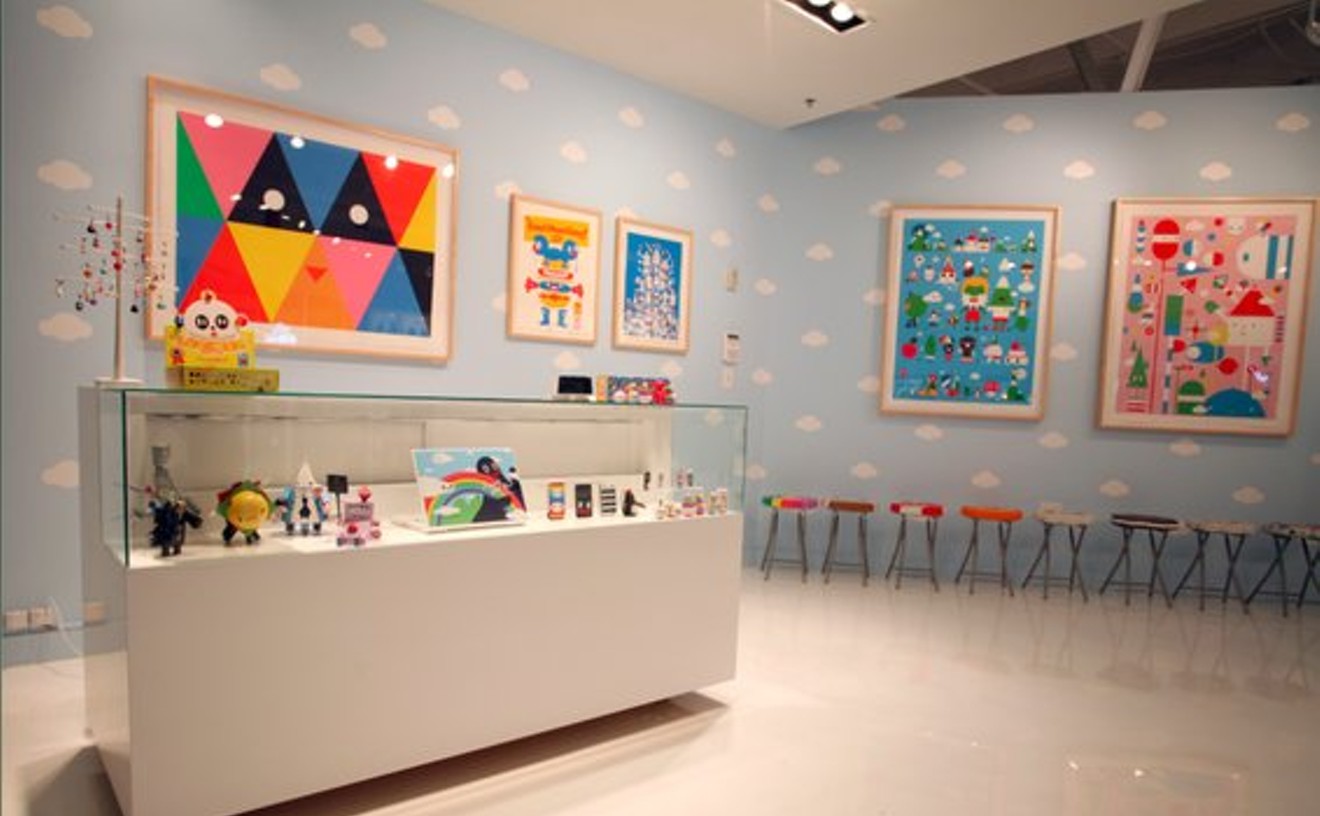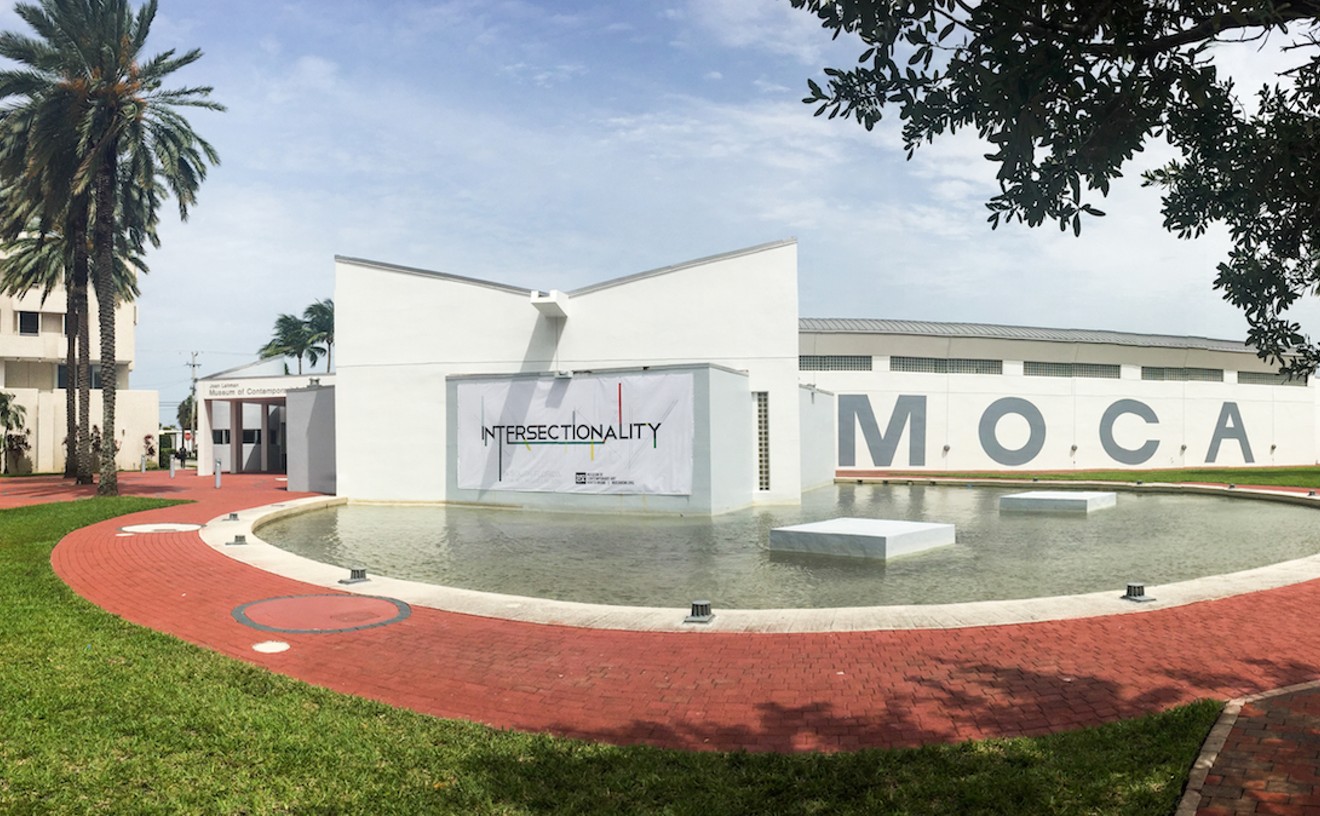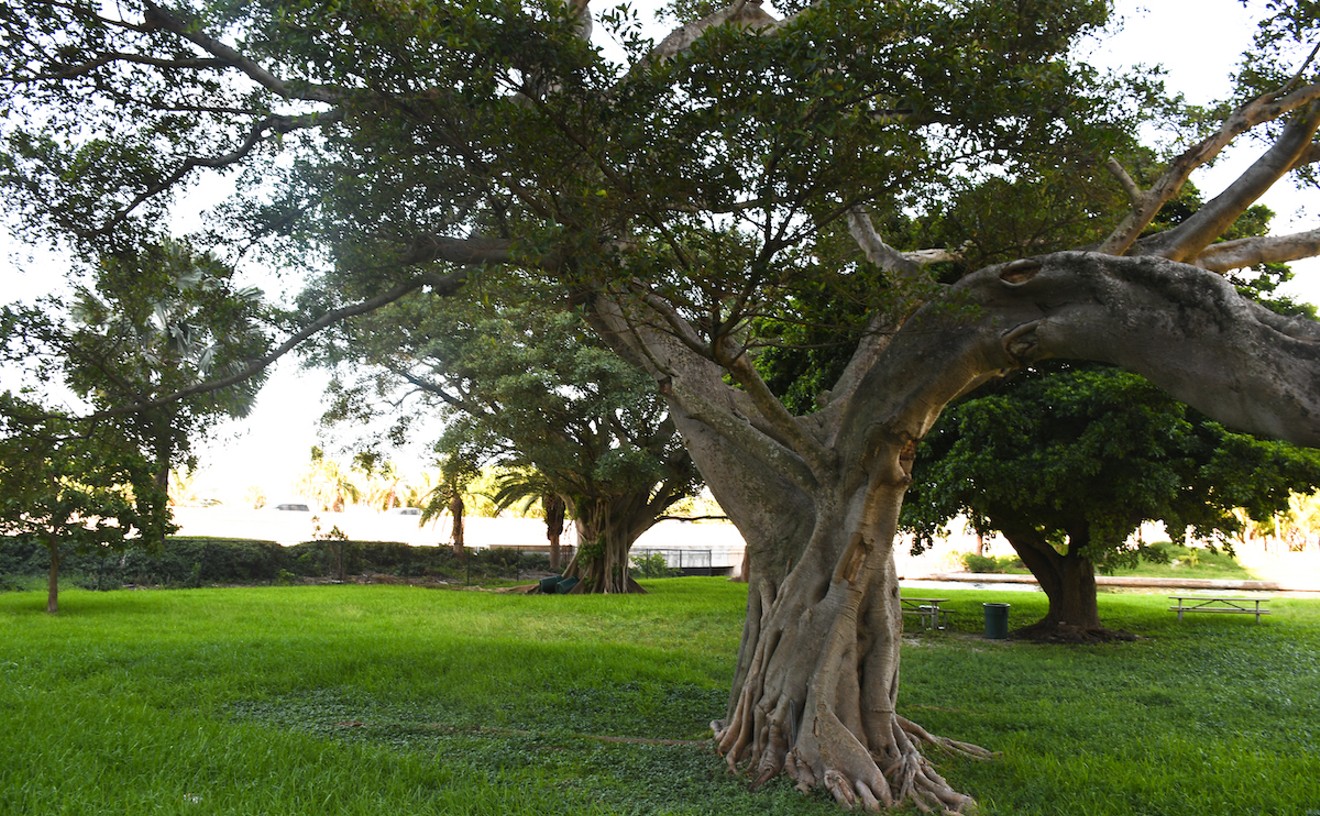You can dress her in a parka, crimp her fur, and keep her in your purse, but don't forget: Your dog is still an animal. A pack animal, and it's time to re-acquaint Princess with her long-forgotten species. The Martell dog park is a wedge of suffering grass in the middle of a severe cement landscape, rimmed on the north and east by I-195 ramps, the west by a condo tower, and the east by Biscayne Bay and the sex offender-habitated Julia Tuttle Causeway. But to the finally unleashed urban dog, this is nothing less than heaven: a tract large enough for an epic game of catch (it's about the size of a little-league park) ornamented with a half-dozen big trees to pee on and, if you time the visit right, a plethora of friends equally interested in ass-odor appreciation. Arrive after 5 p.m. on a workday — parking is tricky, so it's wise to drop off your car a few blocks away and make the walk — and the place is packed with downtown-residing yuppies and their toaster-size canines. Run free, purse dogs!
Best Local Artists
Friends with You

Since tag-teaming in 2002 to form their Friends with You collective, Sam Borkson and Arturo Sandoval III have been on a tear to corner the globe with their vision of magic, luck, and friendship. The Miami-based conceptual duo started off creating a line of designer toys featuring a wacky cast of cosmic characters with names such as Buddy Chub, Fluffy Pop, Bumble Grump, Red Flyer, Albino Squid, and Malfi. Since then, their mysterious creations have opened portals of opportunity for the artists they could scarcely imagine. Their premium toy line can now be found in some of the top boutiques across the planet. They have carved out their own niche in the contemporary art world with their eye-popping installations, performances, paintings, prints, sculptures, and multimedia works also draw the attention of corporate moguls. Some of the clients they have seduced with their otherworldly charms include MTV, VH1, Nickelodeon, Comedy Central, Nike, Volkswagen, Toyota Scion, Red Bull, Target, Sony, BMW, Mini Cooper, Hasbro, and VitaminWater, among others. Borkson and Sandoval's neck-craning projects have become a staple during Art Basel Miami Beach, including a spacey blimp parade in 2006 and this past December's giant bounce house at the Scope Art Fair. In the past few years, these big-dreaming homeboys have repped the 305 in places as far-flung as New York, Los Angeles, Berlin, Tokyo, Hong Kong, and Copenhagen — all under the simple rubric "Come Play with Us!" — while conjuring an undeniably winning franchise.
- 3930 NE 2nd Ave., Miami, 33137 Map
- 305-722-8484
- www.friendswithyou.com
Best Local Politician
Michelle Spence-Jones
She was elected in 2005 and not a moment has passed without controversy for Miami Commissioner Michelle Spence-Jones. Her former political opponent, Richard Dunn, sued her in Miami-Dade Circuit Court the second she took office, claiming she bought votes, and two years later, commission colleague Marc Sarnoff accused her of public corruption. Yet in spite of the troubles dogging her short political career, Spence-Jones has not only survived Miami's cutthroat politics but also successfully leveraged her position to help the people who matter to her — the predominantly black residents living in Overtown, Liberty City, Allapattah, and other low-income neighborhoods in her district. Under her watch, the Overtown/Park West Community Redevelopment Agency has finally begun to make inroads in revitalizing the long-neglected historically black community. She made sure the agency spent millions of dollars fixing up storefronts and streets along NW Third Avenue in Overtown, including a $752,903 renovation of Jackson Soul Food Restaurant. Yet Spence-Jones didn't really flex her political muscle until it came time for her to vote for the controversial Marlins stadium deal. Fresh from maternity leave, Spence-Jones channeled great late black leaders M. Athalie Range and Arthur Teele Jr., leveraging her vote to make sure her constituents were taken care of. If the Overtown CRA didn't get $500 million it was promised from the city and county, she would vote against the stadium. An avalanche of criticism descended on Spence-Jones. But she held her ground. Her gambit paid off. She got the $500 million for Overtown. Florida International University political science professor Marvin Dunn sums up the commissioner: "I have nothing but praise for the stand that Spence-Jones has taken: Show us the money. Nothing wrong with that. Bringing home the proverbial bacon is what we expect our politicians to do."
Best Art Gallery
Gallery Diet

As far as local dealers go, Nina Johnson has earned her spurs on the local scene as a tireless dynamo and community activist. Her gallery has become a favorite hub for art lovers searching for provocative exhibitions that linger in the mind long after one leaves her lively, shape-shifting space. Since opening its doors in November 2007, Diet has become known for its modest yet focused stable of emerging and mid-career artists as well as an invitational program for international artists. Johnson has also organized lectures by visiting curators and critics, and publishes an electronic newsletter featuring reviews and interviews written by local artists on Miami's booming scene. Best of all, Johnson is among the rare handful of local dealers confident enough to give her artists free run of her space without waffling on the commercial necessity of hewing to the bottom line. Her shows are impeccably curated and often among the most discussed after the monthly Wynwood crawls. Among recent standouts were Maria Jose Arjona's beguiling performance marathon, "Remember to Remember," and Andrew Mowbray's witty "Tempest Prognosticator," in which the artist turned himself into a human weathervane. This past December, Brian Burkhardt transformed Diet into a veritable mad scientist's project, installing a sprawling bio-dome-cum-studio that housed samples of the hybrid species of plants and insects he has created during his career. For many people suffering from the bloated offerings that typically cramp the bowels during Wynwood's monthly openings, Johnson has proven a deft hand at trimming the fat from the bone.
- 6315 NW Second Ave., Miami, 33150 Map
- 305-571-2288
- ninajohnson.com
Best Political Coup
Dennis Moss elected county commission chairman
For years, the county commission has been controlled by a certain block of rabidly pro-growth commissioners who are quite cozy with special interests. That all changed when Dennis Moss built a more moderate coalition that got him elected as chairman. Moss, whose District 9 is a geographically sprawling chunk of Southern Dade, then set forth assigning committee chairs. Left out in the cold was Commissioner Natacha Seijas, whose derrière was so used to sitting in a chairman's spot it almost seemed like a foregone conclusion she'd be in charge of something. Of course, with growth at a standstill thanks to the economic slump, Seijas and her ilk seem sort of aimless anyway.
Best Art Exhibit
"Sympathy for the Devil: Art and Rock and Roll Since 1967"

This nearly pitch-perfect exhibition, organized by curator Dominic Molon over a five-year span, explored the deep-rooted and primal alliances between rebellious spirits haunting both the sonic and visual realms. It featured more than 100 paintings, drawings, installations, and videos by 56 artists and artist collectives. The show was organized by the Museum of Contemporary Art in Chicago, where it drew stadium-size crowds. MoCA's turnstile numbers skyrocketed as well. Although some knuckleheads wailed about holes in the exhibition's version of rock history, you couldn't leave without giving this devil his due.
- 770 NE 125th St., North Miami, 33161 Map
- 305-893-6211
- mocanomi.org
Best Quote
"I won't be punked."
"I won't be punked," Florida Congresswoman Ileana Ros-Lehtinen proclaimed.
After all, former vice presidential candidate Sarah Palin was duped by a radio station into taking a call from a fake French President Nicolas Sarkozy. So when President-elect Barack Obama called to congratulate Ros-Lehtinen on her re-election victory — a move he hoped would build a bridge of nonpartisanship with the Republican congresswoman — well, Ileana would not be punked like Sarah was.
"You are either very gracious to reach out in such a bipartisan manner or had run out of folks to call if you are truly calling me," Ros-Lehtinen told the prankster. "And Saturday Night Live could use a good Obama impersonator like you." And then she hung up. Shortly afterward, she received a call from Rahm Emanuel, telling her that she had just hung up on the president. Again, Ros-Lehtinen would not be fooled! And hung up. Again. Problem is, it really was President-elect Obama and his chief of staff calling. It wasn't until a fellow member of the U.S. House of Representatives, Howard Berman, called to assure her that she was not the target of a prank that Ros-Lehtinen finally took the call from the POTUS. After all, who the hell does impressions of Howard Berman?
Best Political Comeback
The Diaz-Balart brothers
It was right there in black-and-white, on the cover of your Miami New Times: "End of the Diaz-Balart Dynasty." Just weeks before election night, scores of polls showed both Mario and Lincoln — Cuban-American icons and Miami's reps in Washington for years — trailing their Democratic challengers. Obama-mentum was sweeping the nation, ripping Red State seats out from under longtime untouchables. Young Cuban-Americans, everyone said, were ready for a change and didn't feel tied to the Republican Party the way their parents did.
Then November 4 rolled around. Like Castro-hating, earmark-eating zombies, the Diaz-Balarts rose from the political graveyard and dominated the polls. Lincoln won 58-42 over former Hialeah Mayor Raul Martinez. Mario smacked down wonder boy Joe Garcia by four points. And the dynasty, for another two years, lives on.
Best Website to Discover the Miami Art Scene
wetheatproject.com
Wet Heat offers an insightful take on a critical moment for our city and the cultural engine driving it. During the past 18 months, Bill Bilowit and Grela Orihuela, originators of the popular site, have been producing documentary content chronicling Miami's new identity as a global arts destination and the players fueling its rise. They began screening the project during last December 2008's Art Basel confab. The arts confluence unfolding on their doorstep and the opportunity to chronicle living history is the Ariadne's thread that binds these films. "Each edition is an in-depth, cinéma vérité, behind-the-scenes profile of a Miami-based artist at a milestone moment in their career," Bilowit states. He and Orihuela recently wrapped filming locals Bert Rodriguez and Hernan Bas for hourlong documentaries respectively, excerpts of which can be viewed online. The documentaries shadow the artists in their studios and at art openings and fairs, and feature interviews with dealers, collectors, critics, and high-art honchos, conveying their development as artists as well as telling the story of Miami's dramatic upswing.
Best Barely Legal Art Blog
MSGCartel.com
Miami has a graffiti style all its own — wild, imaginative, and full of tropical color. MSG Cartel claims it's only an "online exhibition" of graffiti, implying its contributors are simply admirers of that particular street art. But browse the site — named for graffiti crew Miami Style Gods — for a while and it becomes clear it's operated by, and is a meeting ground for, Miami's most prolific illegal artists, from Crome and Crook to Atomik. The photos posted constitute a de facto hall of fame for some of the most skilled local wall work. After Kendall graffiti artist Merk fell to his death while spray-painting a highway overpass, the blog became a memorial ground. It's a daily updated finger on the pulse of a naturally reclusive subculture.






